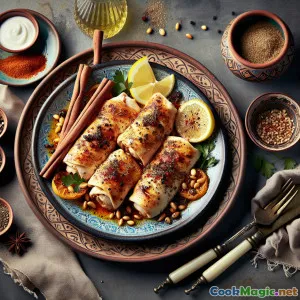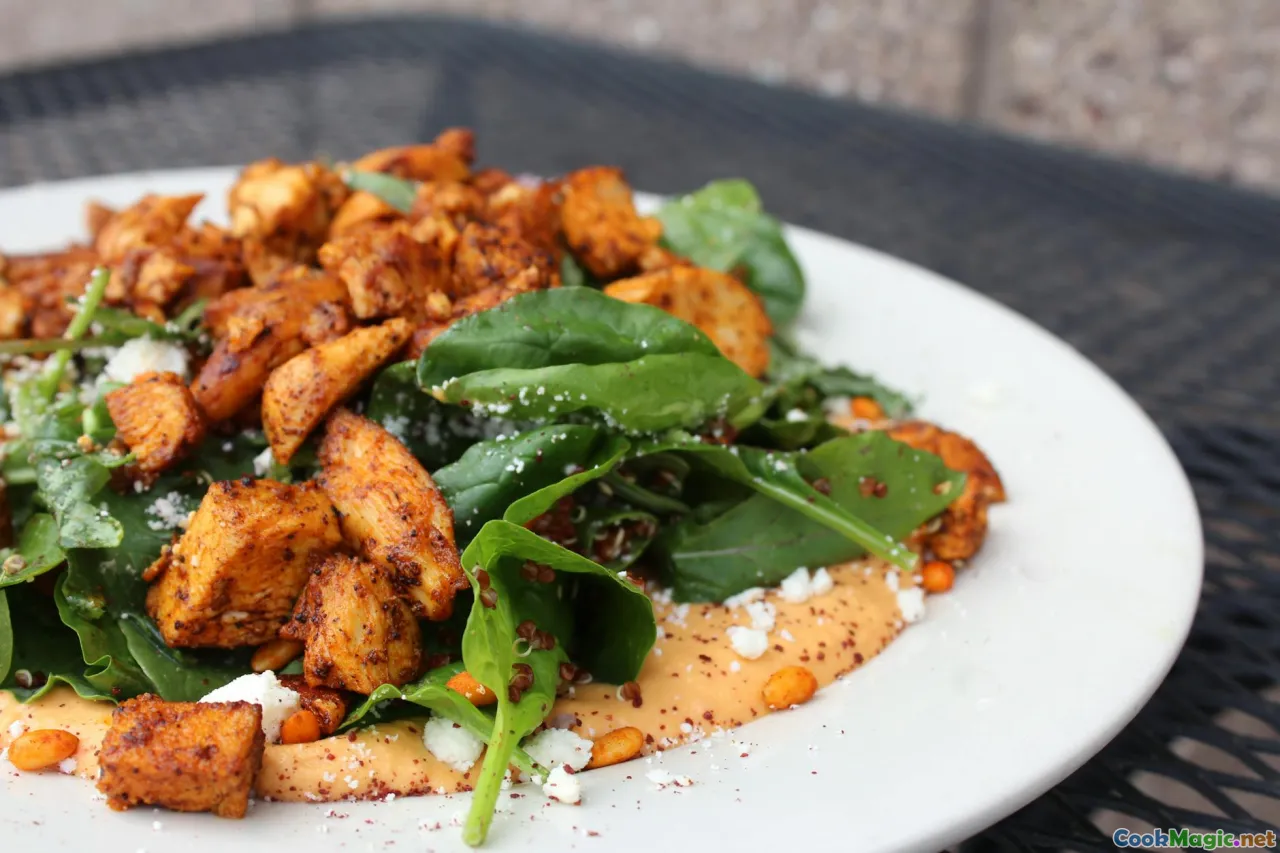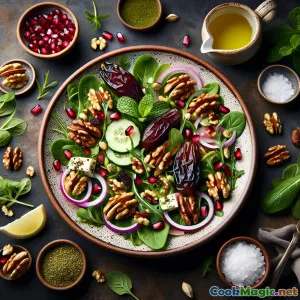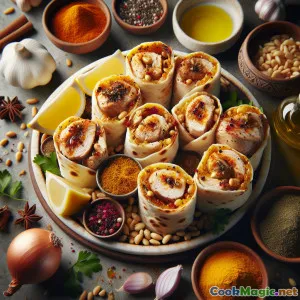
酥脆的苏木籽香味 Musakhan 鸡肉卷
(Crispy Sumac Musakhan Chicken Rolls)
(0 评论)食材
-
700 grams 去骨去皮鸡大腿
(Thighs stay juicy; breast works in a pinch)
-
600 grams 黄洋葱,切成薄片
(Traditional musakhan uses generous onions softened in olive oil)
-
6 tbsp 橄榄油
(Extra-virgin for the onions and marinade)
-
3 tbsp 研磨苏木
(Deep ruby, tangy; the soul of musakhan)
-
2 tbsp 新鲜柠檬汁
(Brightens the sumac-onion mixture)
-
4 cloves 大蒜瓣,切碎
(Smashed or finely minced)
-
1 tsp 磨碎的多香果
(Adds warm Levantine depth)
-
0.5 tsp 肉桂粉
(Optional fragrant sweetness)
-
0.75 tsp 现磨黑胡椒
(根据口味调整)
-
1.25 tsp 细海盐
(Season onions and chicken)
-
50 grams 松子
(Toast until golden for extra nuttiness)
-
6 pieces Taboon 或薄饼(saj/markook)
(Large, flexible breads; tortillas in a pinch)
-
2 tbsp 酥油或澄清黄油
(Traditional richness in the onion confit)
-
100 grams 原味全脂酸奶
(Quick tenderizing marinade for chicken)
-
120 ml 鸡汤或水
(Keeps filling juicy and saucy)
-
2 tbsp 新鲜切碎的欧芹
(Herbal finish)
-
1 tsp 白醋
(Boosts acidity if lemons are mild)
-
1 tbsp 芝麻
(For crunchy tops)
-
1 tbsp 细磨苏木粉,用于收尾
(Dust over baked rolls)
-
2 tbsp 刷涂用橄榄油
(Brush rolls before baking for crispness)
(Thighs stay juicy; breast works in a pinch)
(Traditional musakhan uses generous onions softened in olive oil)
(Extra-virgin for the onions and marinade)
(Deep ruby, tangy; the soul of musakhan)
(Brightens the sumac-onion mixture)
(Smashed or finely minced)
(Adds warm Levantine depth)
(Optional fragrant sweetness)
(根据口味调整)
(Season onions and chicken)
(Toast until golden for extra nuttiness)
(Large, flexible breads; tortillas in a pinch)
(Traditional richness in the onion confit)
(Quick tenderizing marinade for chicken)
(Keeps filling juicy and saucy)
(Herbal finish)
(Boosts acidity if lemons are mild)
(For crunchy tops)
(Dust over baked rolls)
(Brush rolls before baking for crispness)
营养
- 份量: 4
- 每份大小: 2 rolls (approx. 280g)
- Calories: 620 kcal
- Carbohydrates: 54 g
- Protein: 34 g
- Fat: 30 g
- Fiber: 6 g
- Sugar: 9 g
- Sodium: 780 mg
- Cholesterol: 95 mg
- Calcium: 120 mg
- Iron: 3.5 mg
制作步骤
-
1 - Marinate the Chicken:
Cut chicken into bite-size strips. Toss with yogurt (if using), 1 tbsp olive oil, 1 tbsp sumac, half the garlic, 1/2 tsp salt, and a pinch of pepper. Set aside 20 minutes while you start the onions.
-
2 - Sweat the onions:
In a wide pan, warm 3 tbsp olive oil (and ghee, if using) over medium heat. Add sliced onions and 1/2 tsp salt. Cook gently, stirring often, until softened and translucent but not deeply browned, 10–12 minutes.
-
3 - Season onions with sumac:
Stir 2 tbsp sumac, lemon juice, vinegar (if using), remaining garlic, allspice, and cinnamon into the onions. Cook 2–3 minutes more to bloom spices; transfer onions to a bowl.
-
4 - Sear the Chicken:
Add 1 tbsp olive oil to the same pan. Increase heat to medium-high. Sear marinated chicken until lightly caramelized and just cooked through, 5–7 minutes.
-
5 - Combine and moisten:
Return the onions to the pan with the chicken. Add stock or water and simmer 2–3 minutes until the mixture is juicy but not watery. Adjust salt and pepper to taste.
-
6 - Toast Pine Nuts:
In a dry skillet over medium heat, toast pine nuts, shaking often, until golden and fragrant, 2–3 minutes. Immediately tip into a bowl to prevent burning.
-
7 - Preheat and prepare breads:
Preheat oven to 200°C (392°F). Warm flatbreads briefly so they’re pliable. Line a baking tray with parchment.
-
8 - Assemble the rolls:
Spread a strip of onion-chicken filling near the lower third of each flatbread. Sprinkle with pine nuts and a pinch of sumac. Fold sides in and roll up tightly, burrito-style, to seal.
-
9 - Brush and bake:
Place rolls seam-side down on the tray. Brush with olive oil, sprinkle sesame seeds (optional), and bake 12–15 minutes until crisp and lightly bronzed.
-
10 - Finish and Serve:
Dust with remaining sumac and parsley. Serve hot with extra lemon wedges or a dollop of yogurt.
Cut chicken into bite-size strips. Toss with yogurt (if using), 1 tbsp olive oil, 1 tbsp sumac, half the garlic, 1/2 tsp salt, and a pinch of pepper. Set aside 20 minutes while you start the onions.
In a wide pan, warm 3 tbsp olive oil (and ghee, if using) over medium heat. Add sliced onions and 1/2 tsp salt. Cook gently, stirring often, until softened and translucent but not deeply browned, 10–12 minutes.
Stir 2 tbsp sumac, lemon juice, vinegar (if using), remaining garlic, allspice, and cinnamon into the onions. Cook 2–3 minutes more to bloom spices; transfer onions to a bowl.
Add 1 tbsp olive oil to the same pan. Increase heat to medium-high. Sear marinated chicken until lightly caramelized and just cooked through, 5–7 minutes.
Return the onions to the pan with the chicken. Add stock or water and simmer 2–3 minutes until the mixture is juicy but not watery. Adjust salt and pepper to taste.
In a dry skillet over medium heat, toast pine nuts, shaking often, until golden and fragrant, 2–3 minutes. Immediately tip into a bowl to prevent burning.
Preheat oven to 200°C (392°F). Warm flatbreads briefly so they’re pliable. Line a baking tray with parchment.
Spread a strip of onion-chicken filling near the lower third of each flatbread. Sprinkle with pine nuts and a pinch of sumac. Fold sides in and roll up tightly, burrito-style, to seal.
Place rolls seam-side down on the tray. Brush with olive oil, sprinkle sesame seeds (optional), and bake 12–15 minutes until crisp and lightly bronzed.
Dust with remaining sumac and parsley. Serve hot with extra lemon wedges or a dollop of yogurt.
关于 酥脆的苏木籽香味 Musakhan 鸡肉卷 :的更多信息
Why these rolls? A portable love letter to musakhan
Musakhan is a beloved Palestinian dish traditionally served as taboon bread lavishly covered with soft onions stained ruby by sumac, generously doused in olive oil, and often crowned with roast chicken and pine nuts. These Sumac Spiced Musakhan Rolls keep the soul of that classic—tangy onions, fragrant spice, toasted nuts—while transforming it into a tidy, party-friendly format. Think crisp-edged wraps with a steamy, lemon-sumac perfume that hits the senses the moment you crack one open.
Technique notes that make the difference
- Onion confit, not caramelization: In musakhan, onions are sweated gently in olive oil. We’re aiming for soft, glossy onions that carry sumac’s tang, not deeply browned sweetness. Keep the heat moderate and salt early to draw out moisture.
- Sumac timing: Blooming sumac briefly with the warm onions releases its citrusy aroma without dulling its tang. Dusting a touch on top after baking restores brightness.
- Juicy balance: A splash of stock or water ensures the filling is moist enough to bind but not so wet that it soaks the bread. You should see a little sheen, not a puddle.
- Toast your nuts: Pine nuts brown in seconds; remove them from the pan promptly to prevent bitterness.
- Roll tight: Warm breads first for flexibility. Tuck in the sides, then roll firmly so the filling doesn’t escape and the edges crisp uniformly.
Ingredient spotlight
- Sumac: This crimson spice, made from dried berries, is the defining note—tart like lemon peel with floral hints. Choose a vivid, brick-red sumac with a lemony aroma. If your sumac tastes flat, brighten with a squeeze of fresh lemon just before serving.
- Onions: Yellow onions provide sweetness to balance the sumac. Slice pole-to-pole for strands that soften without disintegrating.
- Chicken thighs: Juicy and forgiving; they withstand high heat and reheating. Yogurt in the quick marinade gently tenderizes and helps seasonings cling.
- Bread: Taboon is traditional, but any thin, flexible flatbread works. Saj, markook, or even large flour tortillas will crisp nicely in the oven.
Variations and substitutions
- Vegetarian: Swap chicken for thick-sliced oyster mushrooms or a mix of mushrooms and chickpeas. Sear until deeply golden before combining with onions.
- Vegan: Use the vegetarian filling above, skip the yogurt, and rely on extra olive oil for richness.
- Gluten-free: Use pliable gluten-free wraps or large rice paper sheets; brush with oil and bake to crisp.
- Nut-free: Replace pine nuts with toasted pumpkin seeds or omit entirely.
- Spice play: Add a pinch of baharat or coriander seed for warmth, or grate in lemon zest for high notes.
Serving ideas and pairings
- A cooling bowl of laban (salted yogurt) or tahini-lemon sauce complements the tang of sumac.
- Pickled turnips, cucumbers, or quick-pickled red onions add crunch and acidity.
- Serve alongside fattoush or a simple tomato-cucumber salad drenched in olive oil.
- For a gathering, slice rolls on the bias and arrange with extra sumac for dusting.
Make-ahead, storage, and reheating
- Fill ahead: The onion-chicken mixture keeps 3 days chilled. Rewarm until steamy before rolling.
- Freeze: Assemble unbaked rolls, freeze on a tray, then bag. Bake from frozen at 200°C, adding 5–7 minutes.
- Reheat: Re-crisp baked rolls in a 190°C oven or air fryer for 6–8 minutes. Avoid microwaving, which softens the bread.
Cultural context and history
Musakhan is deeply tied to the olive harvest across Palestine—new-season olive oil meeting sumac and onions on warm taboon. Families gather around vast, bread-lined platters, tearing pieces by hand. While the roll format isn’t traditional, it respects the core flavors and makes the dish accessible in lunchboxes, picnics, and potlucks, helping the story of musakhan travel. Each bite carries the terroir of Levantine hillsides: tart sumac from wild shrubs, onions mellowed in oil, and the gentle embrace of allspice.
Troubleshooting
- Rolls unravelling? Warm the breads longer and roll tighter, seam-side down. A light brush of oil helps seal.
- Too sour? Balance with a pinch of sugar or extra olive oil.
- Too dry? Add another splash of stock to the filling before rolling.
- Pale tops? Extend bake time a few minutes or finish under a hot broiler, watching closely.
Personal notes
I love to dust the cutting board with a little sumac before rolling—the edges pick up a blush that broadcasts flavor before you even bite. These rolls are a delicious handshake between heritage and convenience: the spirit of a communal platter captured in a crisp, handheld package. Bring them to the table with pride, then watch them disappear.





















